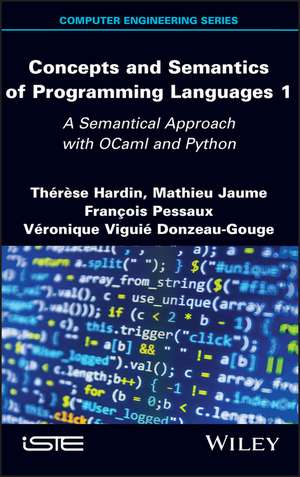Concepts and Semantics of Programming Languages 1 – A Semantical Approach with OCaml and Python
Autor T Hardinen Limba Engleză Hardback – 17 iun 2021
This book is intended not only for computer science students and teachers but also seasoned programmers, who will find a guide to reading reference manuals and the foundations of program verification.
Preț: 985.01 lei
Preț vechi: 1082.42 lei
-9% Nou
Puncte Express: 1478
Preț estimativ în valută:
188.49€ • 197.70$ • 156.91£
188.49€ • 197.70$ • 156.91£
Carte tipărită la comandă
Livrare economică 01-15 aprilie
Preluare comenzi: 021 569.72.76
Specificații
ISBN-13: 9781786305305
ISBN-10: 1786305305
Pagini: 336
Dimensiuni: 198 x 243 x 24 mm
Greutate: 0.63 kg
Editura: ISTE Ltd.
Locul publicării:Hoboken, United States
ISBN-10: 1786305305
Pagini: 336
Dimensiuni: 198 x 243 x 24 mm
Greutate: 0.63 kg
Editura: ISTE Ltd.
Locul publicării:Hoboken, United States
Cuprins
Foreword xi
Preface xiii
Chapter 1. From Hardware to Software 1
1.1. Computers: a low-level view 1
1.1.1. Information processing 1
1.1.2. Memories 2
1.1.3. CPUs 3
1.1.4. Peripheral devices 7
1.2. Computers: a high-level view 8
1.2.1. Modeling computations 9
1.2.2. High-level languages 9
1.2.3. From source code to executable programs 10
Chapter 2. Introduction to Semantics of Programming Languages 15
2.1. Environment, memory and state 16
2.1.1. Evaluation environment 16
2.1.2. Memory 18
2.1.3. State 20
2.2. Evaluation of expressions 21
2.2.1. Syntax 21
2.2.2. Values 22
2.2.3. Evaluation semantics 24
2.3. Definition and assignment 26
2.3.1. Defining an identifier 26
2.3.2. Assignment 29
2.4. Exercises 31
Chapter 3. Semantics of Functional Features 35
3.1. Syntactic aspects 35
3.1.1. Syntax of a functional kernel 35
3.1.2. Abstract syntax tree 36
3.1.3. Reasoning by induction over expressions 39
3.1.4. Declaration of variables, bound and free variables 39
3.2. Execution semantics: evaluation functions 42
3.2.1. Evaluation errors 42
3.2.2. Values 43
3.2.3. Interpretation of operators 45
3.2.4. Closures 46
3.2.5. Evaluation of expressions 47
3.3. Execution semantics: operational semantics 54
3.3.1. Simple expressions 55
3.3.2. Call-by-value 56
3.3.3. Recursive and mutually recursive functions 60
3.3.4. Call-by-name 61
3.3.5. Call-by-value versus call-by-name 62
3.4. Evaluation functions versus evaluation relations 64
3.4.1. Status of the evaluation function 64
3.4.2. Induction over evaluation trees 65
3.5. Semantic properties 69
3.5.1. Equivalent expressions 69
3.5.2. Equivalent environments 71
3.6. Exercises 71
Chapter 4. Semantics of Imperative Features 77
4.1. Syntax of a kernel of an imperative language 77
4.2. Evaluation of expressions 81
4.3. Evaluation of definitions 86
4.4. Operational semantics 89
4.4.1. Big-step semantics 89
4.4.2. Small-step semantics 93
4.4.3. Expressiveness of operational semantics 95
4.5. Semantic properties 96
4.5.1. Equivalent programs 96
4.5.2. Program termination 98
4.5.3. Determinism of program execution 100
4.5.4. Big steps versus small steps 103
4.6. Procedures 109
4.6.1. Blocks 109
4.6.2. Procedures 112
4.7. Other approaches 118
4.7.1. Denotational semantics 118
4.7.2. Axiomatic semantics, Hoare logic 129
4.8. Exercises 134
Chapter 5. Types 137
5.1. Type checking: when and how? 139
5.1.1. When to verify types? 139
5.1.2. How to verify types? 140
5.2. Informal typing of a program Exp2 141
5.2.1. A first example 141
5.2.2. Typing a conditional expression 142
5.2.3. Typing without type constraints 142
5.2.4. Polymorphism 143
5.3. Typing rules in Exp2 143
5.3.1. Types, type schemes and typing environments 143
5.3.2. Generalization, substitution and instantiation 146
5.3.3. Typing rules and typing trees 151
5.4. Type inference algorithm in Exp2 154
5.4.1. Principal type 154
5.4.2. Sets of constraints and unification 155
5.4.3. Type inference algorithm 159
5.5. Properties 167
5.5.1. Properties of typechecking 167
5.5.2. Properties of the inference algorithm 167
5.6. Typechecking of imperative constructs 168
5.6.1. Type algebra 168
5.6.2. Typing rules 169
5.6.3. Typing polymorphic definitions 171
5.7. Subtyping and overloading 172
5.7.1. Subtyping 173
5.7.2. Overloading 175
Chapter 6. Data Types 179
6.1. Basic types 179
6.1.1. Booleans 179
6.1.2. Integers 181
6.1.3. Characters 186
6.1.4. Floating point numbers 187
6.2. Arrays 191
6.3. Strings 194
6.4. Type definitions 194
6.4.1. Type abbreviations 195
6.4.2. Records 196
6.4.3. Enumerated types 200
6.4.4. Sum types 202
6.5. Generalized conditional 205
6.5.1. C style switch/case 205
6.5.2. Pattern matching 208
6.6. Equality 216
6.6.1. Physical equality 217
6.6.2. Structural equality 218
6.6.3. Equality between functions 220
Chapter 7. Pointers and Memory Management 223
7.1. Addresses and pointers 223
7.2. Endianness 225
7.3. Pointers and arrays 225
7.4. Passing parameters by address 226
7.5. References 229
7.5.1. References in C++ 229
7.5.2. References in Java 233
7.6. Memory management 234
7.6.1. Memory allocation 234
7.6.2. Freeing memory 237
7.6.3. Automatic memory management 239
Chapter 8. Exceptions 243
8.1. Errors: notification and propagation 243
8.1.1. Global variable 245
8.1.2. Record definition 245
8.1.3. Passing by address 245
8.1.4. Introducing exceptions 246
8.2. A simple formalization: ML-style exceptions 247
8.2.1. Abstract syntax 247
8.2.2. Values 248
8.2.3. Type algebra 248
8.2.4. Operational semantics 248
8.2.5. Typing 250
8.3. Exceptions in other languages 250
8.3.1. Exceptions in OCaml 251
8.3.2. Exceptions in Python 251
8.3.3. Exceptions in Java 253
8.3.4. Exceptions in C++ 254
Conclusion 257
Appendix: Solutions to the Exercises 259
List of Notations 287
Index of Programs 289
References 293
Index 295
